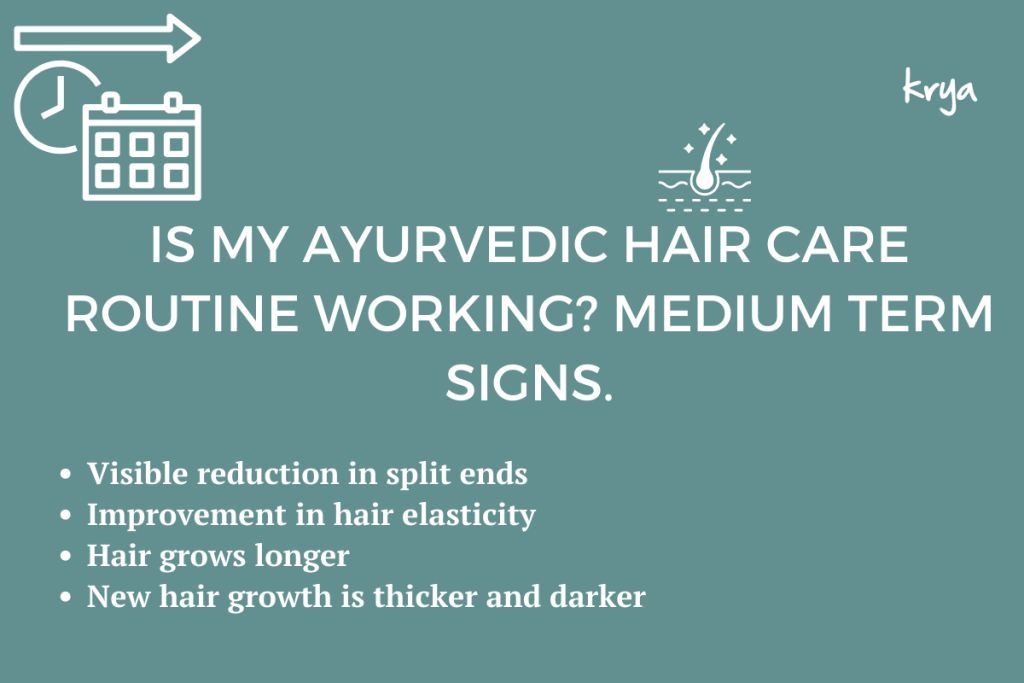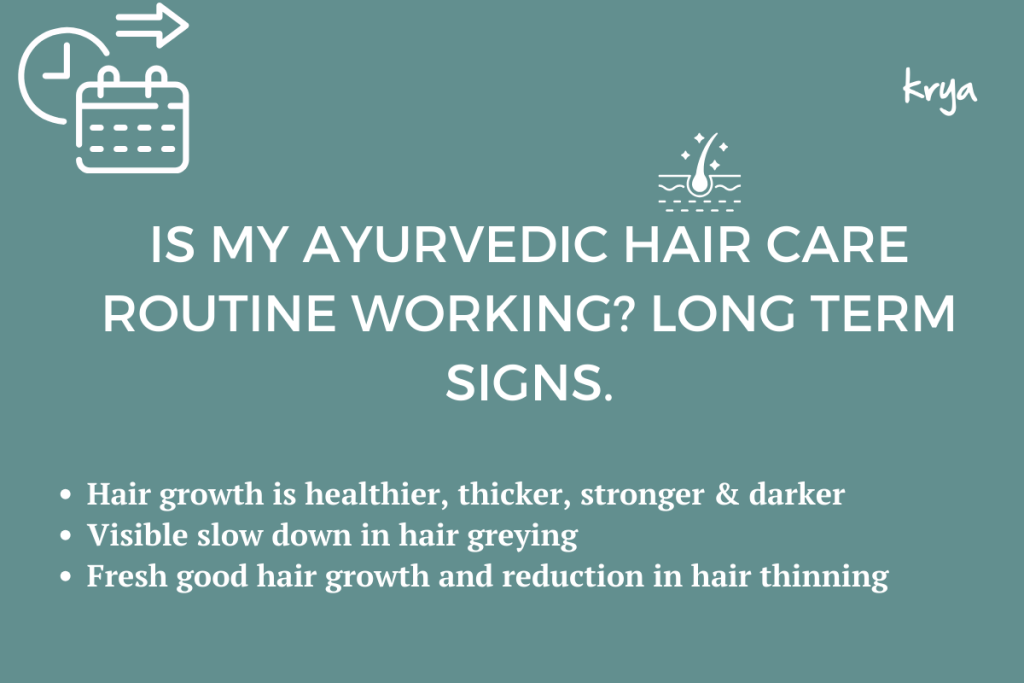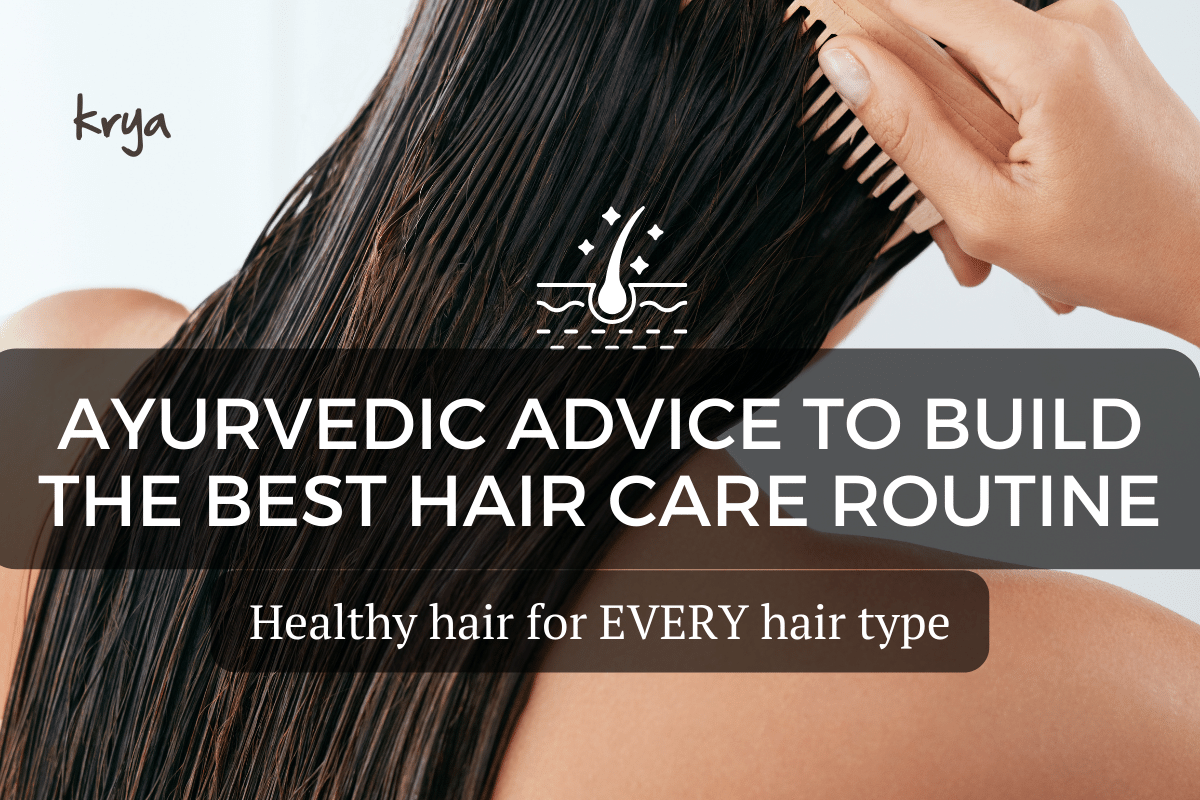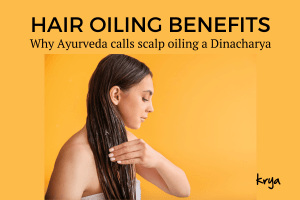This post was last updated on January 30, 2024 by Preethi Sukumaran
Looking for the best hair care routine for your hair type? Confused by the conflicting advice available on how to care for and maintain healthy hair? Worried about the effect of excessive chemicals on your scalp health?
Why is an Ayurvedic hair care routine even more relevant today?
As a company invested in Ayurvedic wellness, we continue to be amazed at the depth and relevance of Ayurvedic advice today. Over the last 20 years, new research has emerged on the toxic after effects of many of the common chemicals used in household and personal care. Even simple chemical detergents like Sulphates, are now known to have estrogenic effects in the long term on marine organisms. Now, more than ever, we need the clean, well thought through, healthy formulations that Ayurveda offers us for hair and skin.

For this piece on building the perfect hair care routine, we turned to Ayurveda, as we always do. The advice Ayurveda offers is detailed and through. It covers every part of a hair care routine from nourishing the scalp, to cleansing it correctly, to how often you wash your hair & even what the right temperature of water is to wash hair!
When we follow the routine , we ensure that the scalp is healthy & produces enough natural oils to keep it well hydrated. We also improve the scalp’s health and positively impact the quality of hair growth.
This Ayurvedic daily hair care routine is simple, easy to follow, and helps protect your hair, reduces hair loss, and improves hair texture and strength.
To address concerns of different hair types, Ayurveda suggests understanding your hair type and texture first. Based on this, we are asked to modify products in the routine and use different Ayurvedic herbs to address differing hair needs. This piece covers this briefly as well.
So if you are here wanting to understand what a good Ayurvedic haircare routine is and what to use for your scalp and hair on a daily & weekly basis, read on.
Unprocessed Indian Hair – The wigmakers & toppers for the whole world
India is THE largest exporter of virgin human hair. A March 2021 report by Aritzon valued the global Wigs & extensions market at 5.8 billion USD. This is expected to reach a market size of 13 billion USD by 2026. 70% of this market is serviced by synthetic hair which is cheaper. But the balance 30% is made up of real human hair most of which is supplied from India.

Indian human hair is given away by devotees in temples and temples auction this human hair. For example, TTD Devasthanam receives hair from nearly 35000 devotees every day which has to be auctioned !
Here’s the catch : with the steadily increasing penetration of shampoos and synthetic hair products, deterioration in water quality and dwindling of traditional hair care practices, Indian hair quality may slowly deteriorate over time.
Indians discovered synthetic shampoos quite late in the day (around the mid 1990s) and synthetic conditioners even later (for the last 15 years). This explains in part why Indian hair was so prized over the world for its health, texture, length and colour.
Why was Indian hair so good in quality? How were we able to produce longer, thicker and stronger hair? The answer lies in our traditional Ayurvedic hair care routine.
Ayurvedic haircare routine for every hair type
Ayurveda is an ancient Indian system of medicine and wellness. It is atleast 5000+ years old . This unique system of health offers deep, well thought through advice on understanding the body and leading a life of better health, better quality of life and balance in emotional, spiritual and physical wellness.
To improve wellness and balance, Ayurveda recommends following both daily wellness routines (Dinacharya) and seasonal wellness routines (Ritucharya).
Some parts of the Ayurvedic hair care routine which we will detail below are covered in the Dinacharya portion or list of daily routine for wellness in Ayurveda. Others form a part of basic Ayurvedic hair care and overall wellness.

Hair health is an important health barometer in Ayurveda. Strong healthy hair is not merely a result of good cosmetic practices in Ayurveda. Ayurveda tells us that truly Good hair health arises as a result of 4 internal health factors:
- good nutrition
- balanced doshas through internal and external practices that helps in
- clear & strong flow of nutrients to all organ systems leading to
- good bone strength and health.
This is an interesting finding from Ayurveda. Ayurvedic science tells us that far from being cosmetic, taking trouble to craft the best hair care routine from Ayurveda, although external, can play a big role in both balancing the 3 doshas. External practices like Abhyanga can help balance the 3 doshas & also help direct the flow of nutrients through the body, leading to better bone health.
Therefore this tells us that the products used in an Ayurvedic hair care routine and their effect on the body and ultimately on good hair health must be of greater depth than a cosmetic routine. An ayurvedic hair care routine must give your hair a greater advantage than regular cosmetic products. How does each part of the Ayurvedic hair care routine work? Why do the products chosen play a big role in this. Lets delve into this below.
Ayurvedic daily hair care routine Step 1 : Scalp Oiling
Scalp oiling is an extremely important part of Ayurvedic hair care. The scalp is to be supported through regular oiling in Ayurveda using a herb infused oil .
Why is this such an important wellness activity in Ayurveda? The head is under danger of constantly getting over heated because of the activity of the brain and eyes.
This excess heat is released through the scalp in the form of sweat through the pores of the scalp. However, in order to release this excess heat, the scalp needs to be well moisturised and hydrated. To encourage the release of excess Pitta and vata dosha, we need to use herbs that will help balance Pitta and vata dosha on the scalp.
Therefore daily scalp oiling is suggested as a Dinacharya in Ayurveda using a specially formulated Pitta and vata balancing hair oil.

Scalp oiling uses a small amount of oil. The idea is to give the scalp a good massage using a small amount of the appropriate Ayurvedic hair oil. Style your hair appropriately after this, and leave the oil on.
A well formulated Ayurvedic hair oil absorbs quickly into the scalp and starts working right away. A sign of that is to monitor how you feel during the day after regular scalp oiling.
With regular ayurvedic scalp oiling, Krya users report feeling calm, in control and being able to focus on the task on hand. This is a sign of good dosha balance in the head. Regular scalp oiling also helps improve the health of your hair. Hair gets stronger, and thicker and resists breakage. Hair colour is darker, and hair texture is shiny and smooth. Hair follicles are healthy, with good hair growth.
Its hard to imagine such a huge plethora of benefits coming in from a seemingly simple practice like hair oiling. But we attest to these benefits both through personal experience and the experience of 1000s of customers from 2016 when we launched the first Krya hair oil. We must however keep in mind that these benefits accrue only if we fulfill these 2 conditions:
- The oil chosen must depend upon your hair type and your hair’s specific needs
- The oil must be prepared in the Classical Ayurvedic method using only Classically approved ayurvedic herbs to offer the long list of benefits give the Classical Ayurvedic texts
What is the ideal scalp oiling routine for healthy hair?
For maintaining and promoting healthy hair growth, we recommend leave on scalp oiling atleast thrice a week. This frequency does depend on your hair type – for extremely dry hair, or curly hair, more oiling occasions could help. In general, if you are able to do a few more occasions, it is even better as the Ayurvedic texts suggest oiling daily.

For this:
- Use a small amount of ayurvedic hair oil – about 1/4 tsp or so
- Work the oil well into your scalp using clean fingers
- Massage the scalp well until there is a feeling of warmth
- Detangle and comb hair and style
- This is best done in the morning
Ayurvedic hair care routine Step 2: Wash your hair with an Ayurvedic Shampoo Powder (Choornam)
The second part to cleansing and maintaining your hair is to use the right combination of Ayurvedic herbs to wash your hair. An ayurvedic hair wash choornam is formulated very differently from a synthetic shampoo. It is a modified version of a dry shampoo, and is usually made using a combination of Ayurvedic herbs, clays and lentils and grains. It contains no synthetic surfactants or detergents. To use this product, you have to add water just before use and mix it into a thick paste. This thick paste is used to cleanse the scalp and hair.
A synthetic shampoo mainly has 3 kinds of ingredients: a detergent to clean hair, silicones to coat hair and hide the damage caused by the detergent and colours and fragrances to trick you into thinking the shampoo is a luxurious and safe product to use. Regular use of synthetic shampoos do damage your hair over time slowing down hair growth, and damaging the alignment and health of the hair strands.

A natural Ayurvedic shampoo powder like Krya’s range of hairwashes are made completely differently from synthetic shampoos. They use different kinds of ayurvedic herbs and grains that perform different functions & keep your hair in good health like:
- Helping release excess Pitta ( heat ) trapped in the scalp
- Gently removes excess oil and dirt
- Does not strip your hair of its natural oils
- Helps restore the acid mantle of hair.
- Helps clean the srotas (minor skin openings) in the scalp well so that the scalp is able to perform all its normal functions.
- Helps improve hair growth through all the above
It’s best to use a correctly formulated and properly manufactured Ayurvedic shampoo powder (choornam) to get all these benefits.
A well formulated Ayurvedic shampoo powder should have these features:
- Different variants available based on hair type and needs
- Should be formulated for your hair type AND manufactured precisely so that the proportion of herbs, lentils and grains are correctly retained
- Should use the right proportion of herbs that cleanse and herbs that condition your hair, bring down Pitta , cleanse the srotas etc. Many brands in this space sell products that contain a high proportion of cleansing herbs which can end up over drying the scalp
Here is a video that explains how an ayurvedic hair wash is different from a synthetic shampoo and also how to use it effectively on hair. Do ensure you follow this correctly to get the most out of your hair. Most importantly, please ensure you always pre-oil your hair before washing it.
A video demo of How to use an Ayurvedic Hair Choornam to wash hair
Ayurvedic hair care routine Step 3 : Hair Lepa (Mask)
The third part of a good Ayurvedic haircare routine is the weekly or fortnightly use of an Ayurvedic Hair Lepa or Hair Mask. An Ayurvedic hair mask (lepa) is designed to deep clean the fine Srotas / follicles of the scalp. The product helps unclog the srotas, release dead cells and debris, and prepare the scalp to receive nourishment better in the form of hair oils. The Hair mask (Lepa) also helps improve dosha balance on the scalp.
The cleanliness, flexibility and health of the srotas & follicles in the scalp decides how much nourishment the scalp can absorb. A dry scalp brought on by excessive shampooing and too little oiling leads to stiff dry Srotas.
With regular use of follicle blocking products like styling gels, serums and conditioners, the Srotas also get clogged. This impairs heat exchange, traps heat within the scalp and also causes build up on the scalp.

To help unclog the Srotas and maintain their health, an Ayurvedic Hair Mask (Lepa) should be used every week. This is especially useful when there is strong persistent fungal dandruff, slow impaired hair growth due to chemical damage or hard water, or when hair is recovering after an illness.
The regular use of an Ayurvedic hair mask (lepa) is an ayurvedic scalp and hair treatment that helps you take better care of your hair. It restores and revitalises the health of the scalp. It shortens the scalp recovery process and improves hair strength and quality. Before starting on a hair mask, do ensure you know your hair type and choose the right Hair mask for your scalp and hair.
Things to remember before you begin an Ayurvedic hair care routine
Ayurvedic hair products dont look like or feel like regular cosmetic hair products
Ayurvedic hair care products are very different from what we are used to. The products are much more raw and earthy looking and on first glance may seem rougher or coarser than synthetics.
This is very far from the truth. Synthetics only look gentle. But as we discovered earlier in this article, they are full of dangerous toxins and are also extremely damaging to hair structure.
In order to keep the products pure and completely synthetic free, at Krya we add no colour, fragrance to our products and make them in choornam (powder) format. So the products will need to be made into a paste at your end with the addition of water.
The oil will have a deep earthy colour from the herbs we add to it and also have an ayurvedic fragrance, and not a synthetic fragrance.
But these differences mean that the products you get are ACTUALLY Pure and good for you.
Ayurvedic hair care products are different to use compared to cosmetic hair products – give this transition some time
An ayurvedic hair care routine is DIFFERENT from a simple cosmetic hair routine. Most of us have many years of practice of using a shampoo, conditioner , serum, and ZERO practice using an ayurvedic hair product.
So if you have come to authentic Ayurveda in search of the best hair care routine, initially the transition will seem difficult. However building a daily hair care routine with Ayurveda offers us so many benefits that this initial discomfort can be worked through. The right hair care routine is not more difficult, but it definitely needs a mindset change.
We are used to not oiling our hair and depending almost solely on a shampoo. So the new regime of depending upon an oil, washing less and also using a Mask could seem hard. But , consistently sticking to these routine gives real, tangible results.
What can you expect in the short term? In the short term you may struggle with this transition. Ayurvedic hair wash choornams are not as harshly cleansing as shampoos. Ayurvedic hair oils come with a herbal aroma. And you may struggle to fit in the Ayurvedic Hair Lepa into your routine. Everyone struggles with the transition in the short term.

But in the long term, this routine works. Stick to it with patience and perseverance.
How to choose the right Krya Hair products for healthy hair
The Krya hair care products are formulated by hair concerns. we suggest picking the hair care regimen that most closely matches your concern. If you have a mix of concerns, use a mix of 2 systems.
- For Hair thinning, super fine hair or high premature greying choose the Krya Classic Plus range.
- For oily hair, oily scalp and mild premature greying, choose from the Krya Classic hair range
- For dry frizzy hair prone to split ends, choose from the Krya conditioning hair range
- For hairfall due to high stress, insomnia and anxiety, choose from the Krya Anti stress Range
- For persistent dandruff especially fungal dandruff or scalp psoriasis choose from the Krya anti dandruff range
- For curly frizzy hair, chemically damaged hair or extensive hard water damage choose from the Krya Damage repair hair range
- For extreme hairfall after long illness or due to long term medication, choose from the Krya Intense hair range.
How to use Ayurvedic hair products correctly – tips for healthy hair
- Dont wash your hair everyday – Washing your hair every day can severely dry out the scalp and weaken hair strands. Ayurveda recommends washing your hair twice a week
- Keep your hair strong and nourish the scalp by regular frequent scalp oiling. This practice is best for your hair and also nourishes the eyes and keeps your mood steady.
- Always pre-oil your hair and scalp one hour before hair wash – this protects hair from the damaging effects of water during your shampoo
- When using an Ayurvedic shampoo powder, rinse your hair very thoroughly – Ayurvedic herbs tend to cling to hair strands and need a bit more rinsing.
- Protect your hair from heat. Heat damages the hair’s protein composition. It also damages the hair follicles. If possible let your hair air dry. Or use a cool setting on your dryer. Avoid blow drying and styling your hair too often.
- Washing your hair with hot water can damage hair follicles and is expressly contraindicated in Ayurveda.
- Do follow the Ayurvedic hair routine to give your hair better strength and health
- Allow your hair to air dry as much as possible to retain the health of hair strands. Avoid using a hair dryer on high heat – if unavoidable, use it on lowest possible heat or cool settings only
- Use Rasanadi choornam everytime you wash your hair to avoid Kapha buildup in the head
Is your Ayurvedic Hair care routine working? Some signs that your hair needs are being met.
The Ayurvedic hair care routine is different from a cosmetic hair routine. We are not just interested in the appearance of hair, but are also trying to correct its basic growth pattern and strength. The Ayurvedic routine works in the long term to correct hair damage, repair the cuticular hair structure and trigger high quality hair growth.
But initially if you are making the transition, how do you figure out if its working?
Depending upon your body’s state of health, your hair may experience these stages one at a time or several at a time. The time taken to cross each stage again depends on your health. For hair issues like hair thinning, poor hair growth or intensive hair fall, we recommend adding a regular Abhyanga programme . These should be taken seriously and followed diligently for good results.
Short – Medium term – 1 – 4 months: (Usually in month 0 people are still getting the hang of using the products correctly)

- Balanced sebum production: hair and scalp stays “cleaner” much longer and needs to be washed less frequently.
- Sufficient sebum production (related to above) : Hair look is not dry as sufficient sebum is produced in the scalp to coat the entire hair strand
- Scalp feels clean and healthy without any visible breaks, flaking or boils
- Hair tangles and breaks less and generates less static
- Hair is smoother and easier to comb.
- Hair reflects light better without any styling products or conditioners used – especially in sunlight. This means that your scalp is producing sufficient sebum and that your hair strands have no or minimal cuticular damage.
Medium to long term – 4 – 9 months

- Visible reduction in split ends despite growth in length
- Hair is able to grow longer – this usually is achieved when scalp is healthy and there is sufficient growth medium for hair to extend in length. This is also achieved when sebum production is sufficient and balanced – when there is too little sebum, hair length is poor and split ends are high as there is not enough sebum to maintain a long strand without damage.
- Hair elasticity improves – so there is less breakage with damp hair, when you dry your hair or when brush your hair (or style it in any way). Wet hair breaks less easily.
- New hair that grows is thicker and blacker
Long term plus – 9 months and higher:

- Hair growth is healthier, thicker and longer
- There is a visible slowing down in hair greying
- There is a filling of hair in previously thinning areas like the crown of the head and the forehead
Do look for these signs of hair improvement when you switch to any of the Krya hair systems. These are ways to monitor the progress in your hair and give you confidence you are on the right track, despite the initial difficulties in switching to a natural system.
Sum up – Ayurvedic advice to build the best hair care routine
Ayurveda is an ancient, yet deeply rooted and relevant health care system. When we apply the Ayurvedic principles correctly and sincerely to different parts of our routine like our skin routine or our hair routine, it gives us transformative results.
Ayurvedic products and the Ayurvedic hair care routine are deep, holistic and well thought out while being genuinely natural. Once you determine your hair type, a good Ayurvedic hair care routine can help you achieve your hair goals without loading your body or the planet with unnecessary toxins.
With the abundance that nature provides us, and the fantastic solid framework that Ayurveda provides us, we do not need to resort to synthetics to care for ourselves and our families. Do write to us with your questions, reflections and if you would like us to write about a particular subject you are seeking answers or insights to.
- Email us your questions.
- WhatsApp us for quick responses on product selection.
- Join the Krya FB community to find your cohort of natural product users and learn from them.






My hair is loving your classic oil. But inspite of oiling every other day, I see it getting dry. Should I increase frequency?
Shuba: Are you washing your hair with our hairwash? Has your diet been high in vata aggravating substances of late?
I am using your hair wash. Later after posting it, I just realized that using your hair oil had made me so conscious of the dryness in hair that I miss it. It was not dry like before but only relative to other days where I usually oil.i like my hair to be oiled now.
Really impressive article. I will start to follow this hair care routine.